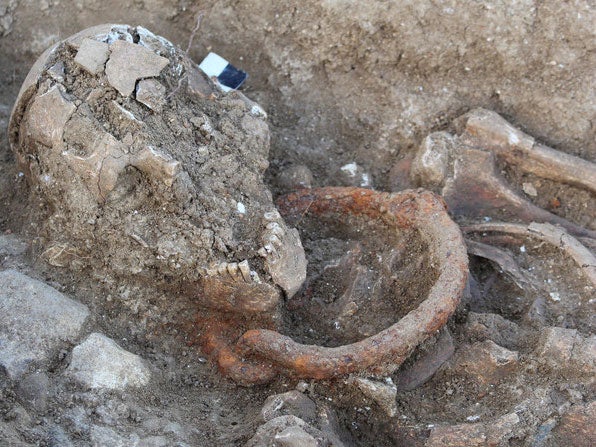Shackled skeletons discovered in ancient Roman burial ground in France
One of the shackled skeletons was that of a child

Your support helps us to tell the story
From reproductive rights to climate change to Big Tech, The Independent is on the ground when the story is developing. Whether it's investigating the financials of Elon Musk's pro-Trump PAC or producing our latest documentary, 'The A Word', which shines a light on the American women fighting for reproductive rights, we know how important it is to parse out the facts from the messaging.
At such a critical moment in US history, we need reporters on the ground. Your donation allows us to keep sending journalists to speak to both sides of the story.
The Independent is trusted by Americans across the entire political spectrum. And unlike many other quality news outlets, we choose not to lock Americans out of our reporting and analysis with paywalls. We believe quality journalism should be available to everyone, paid for by those who can afford it.
Your support makes all the difference.Archaeologist have discovered a group of skeletons bound by shackles at the site of a large ancient Gallo-Roman burial ground in southwest France.
The excavation site lies around 250m west of the Saintes amphitheatre, where wild animals and gladiators would battle thousands of years ago.
In what experts believe to be an important necropolis possibly used for those killed in the stadium, hundreds of graves dating back to the first and second centuries AD were unearthed.
But perhaps the most interesting finds were five shackled skeletons - four adults and one child. Three skeletons had their ankles bound with iron chains, another was secured around the neck, and a child was found with a chain around his or her wrist.
Many of the other skeletons at the site were buried with their heads and toes touching, in rectangular trench-like pits.
Archaeologists were made aware of the necropolis last year, and hope they can now determine how each person died, their status when they were alive and whether they lived in the same communities.
Roman necropolises were generally situated out of towns in the countryside, and were used for burials and cremations.
While people were sometimes buried with their belongings, the archaeologists in southwest France only found a few vases alongside a man, and a child with coins resting on its eyes, Mail Online reported.
Romans believed that by burying a person with coins, his or her spirit could pay the underworld's ferryman and they would safely make it to the afterlife.
Join our commenting forum
Join thought-provoking conversations, follow other Independent readers and see their replies
Comments